2009 TOYOTA 4RUNNER trailer
[x] Cancel search: trailerPage 3 of 520

1
2
3
4
5
6
7
3
Rear window wiper and washer .............................. 165
2-4. Using other driving systems Cruise control ...................... 166
Electronically modulated air suspension................... 169
AUTO LSD system (2WD models and
Multi-mode 4WD
models) ............................. 175
Four-wheel drive system (4WD models) ................... 177
Active traction control system (L4 mode on 4WD
models) ............................. 182
Rear differential lock system .............................. 184
Downhill Assist Control ....... 186
Driving assist systems ........ 188
2-5. Driving information Off-road precautions ........... 198
Cargo and luggage ............. 203
Vehicle load limits ............... 211
Winter driving tips ............... 213
Trailer towing ...................... 216
Dinghy towing ..................... 228
3-1. Using the air conditioning
system a nd defogger
Air conditioning system ....... 230
Rear window and outside rear view mirror defoggers ....... 240 3-2. Using the audio system
Audio system (without
navigation system)
............. 241
Using the radio ................... 244
Using the CD player ........... 250
Playing back MP3 and WMA discs ....................... 257
Optimal use of the audio system .............................. 266
Using the AUX adapter....... 269
Using the steering wheel audio switches.................. 271
3-3. Using the rear audio/video
system
Rear seat entertainment system .............................. 274
Using the DVD player (DVD video)...................... 280
Using the DVD player (video CD) ........................ 288
Using the DVD player (audio CD/CD text) ........... 291
Using the DVD player (MP3 discs) ...................... 292
Using the video mode......... 294
Changing the Setup Menu settings ............................. 297
3-4. Using the interior lights Interior lights list ................. 305
• Personal lights.................. 306
• Personal/interior lights...... 307
• Interior light ...................... 307
3-5. Using the storage features List of storage features ....... 309
• Glove box ......................... 310
• Coin holder ....................... 311
3Interior features
Page 131 of 520

When driving2
131
2-1. Driving proceduresDriving the vehicle............ 132
Engine (ignition) switch .... 140
Automatic
Transmission.... 143
Turn signal lever .............. 145
Parking brake ................... 146
Horn ................................. 147
2-2. Instrument cluster Gauges and meters ......... 148
Indicators and warning lights .............................. 151
Accessory meter .............. 155
2-3. Operating the lights and wipers
Headlight switch ............... 158
Fog light switch ................ 162
Windshield wipers and washer ........................... 163
Rear window wiper and washer ........................... 165 2-4. Using other driving systems
Cruise control ................... 166
Electronically modulated air suspension ................ 169
AUTO LSD system (2WD models and
Multi-mode 4WD
models) .......................... 175
Four-wheel drive system (4WD models) ................ 177
Active traction control system (L4 mode on
4WD models) ................. 182
Rear differential lock system ........................... 184
Downhill Assist Control .... 186
Driving assist systems ..... 188
2-5. Driving information Off-road precautions ........ 198
Cargo and luggage .......... 203
Vehicle load limits ............ 211
Winter driving tips ............ 213
Trailer towing ................... 216
Dinghy towing .................. 228
Page 133 of 520
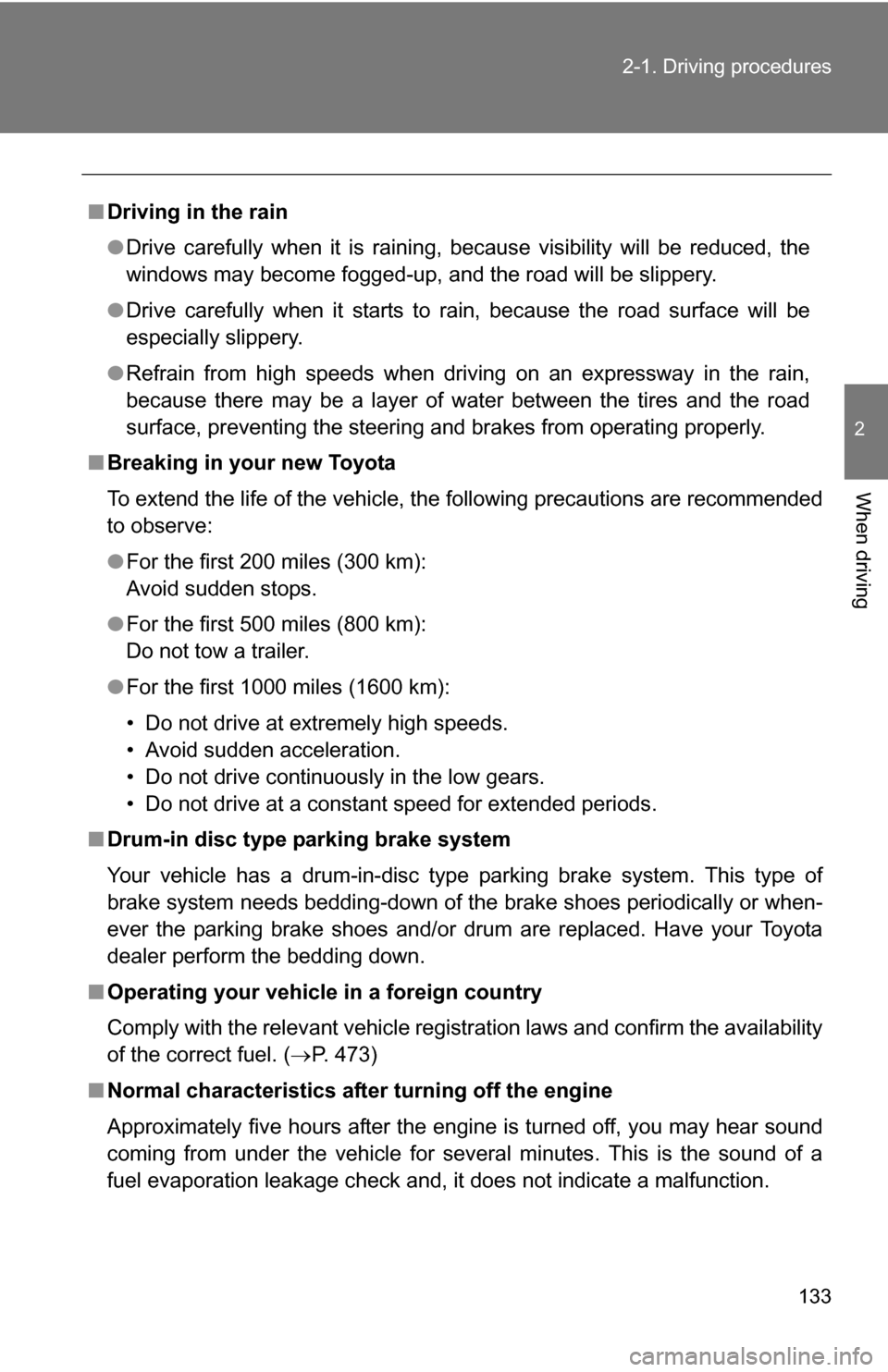
133
2-1. Driving procedures
2
When driving
■
Driving in the rain
●Drive carefully when it is raining, because visibility will be reduced, the
windows may become fogged-up, and the road will be slippery.
● Drive carefully when it starts to rain, because the road surface will be
especially slippery.
● Refrain from high speeds when driving on an expressway in the rain,
because there may be a layer of water between the tires and the road
surface, preventing the steering and brakes from operating properly.
■ Breaking in your new Toyota
To extend the life of the vehicle, the following precautions are recommended
to observe:
●For the first 200 miles (300 km):
Avoid sudden stops.
● For the first 500 miles (800 km):
Do not tow a trailer.
● For the first 1000 miles (1600 km):
• Do not drive at extremely high speeds.
• Avoid sudden acceleration.
• Do not drive continuously in the low gears.
• Do not drive at a constant speed for extended periods.
■ Drum-in disc type parking brake system
Your vehicle has a drum-in-disc type parking brake system. This type of
brake system needs bedding-down of the brake shoes periodically or when-
ever the parking brake shoes and/or drum are replaced. Have your Toyota
dealer perform the bedding down.
■ Operating your vehicle in a foreign country
Comply with the relevant vehicle registration laws and confirm the availability
of the correct fuel. ( P. 473)
■ Normal characteristics afte r turning off the engine
Approximately five hours after the engine is turned off, you may hear sound
coming from under the vehicle for several minutes. This is the sound of a
fuel evaporation leakage check and, it does not indicate a malfunction.
Page 168 of 520
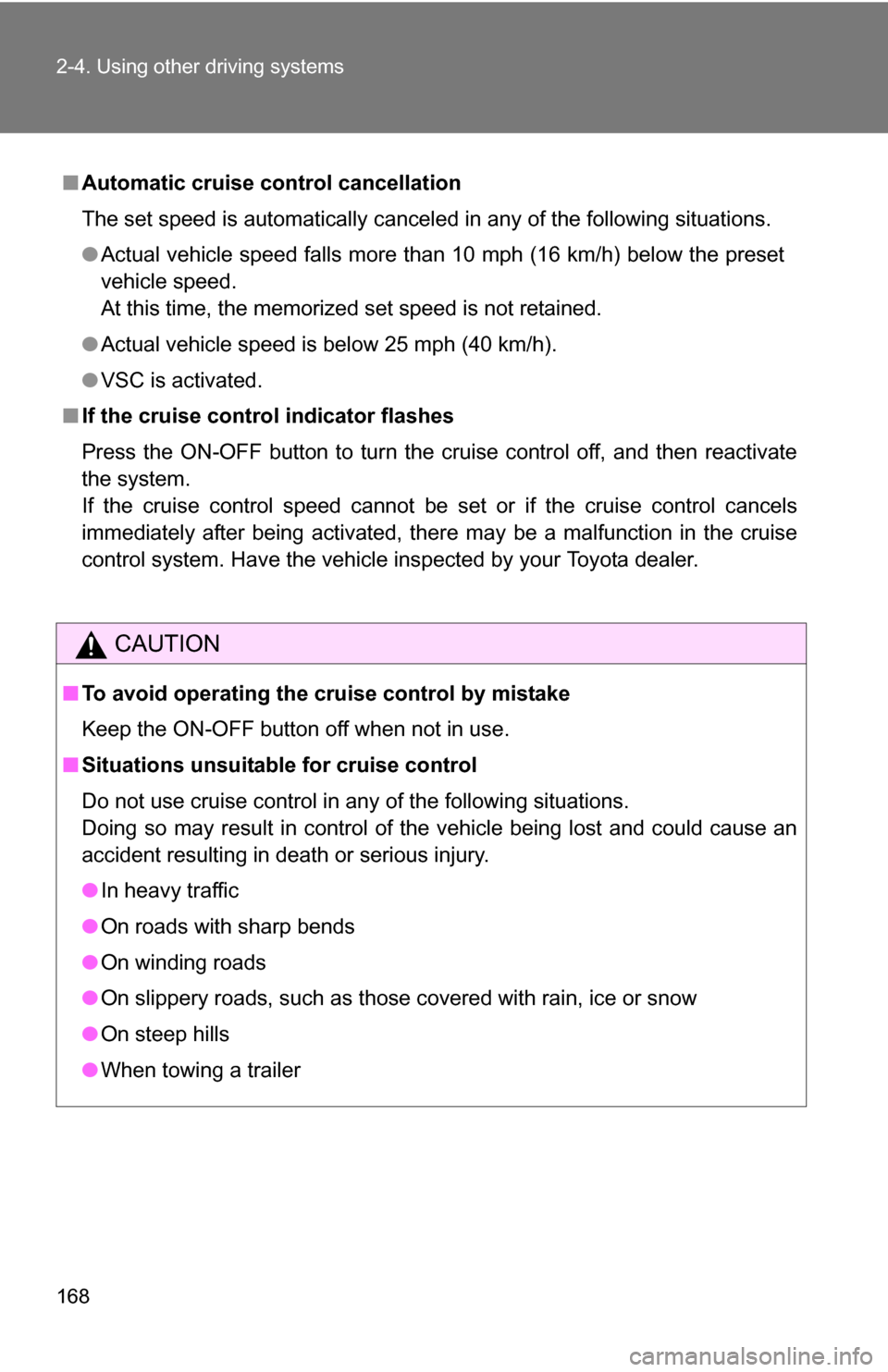
168 2-4. Using other driving systems
■Automatic cruise control cancellation
The set speed is automatically canceled in any of the following situations.
●Actual vehicle speed falls more than 10 mph (16 km/h) below the preset
vehicle speed.
At this time, the memorized set speed is not retained.
● Actual vehicle speed is below 25 mph (40 km/h).
● VSC is activated.
■ If the cruise control indicator flashes
Press the ON-OFF button to turn the cruise control off, and then reactivate
the system.
If the cruise control speed cannot be set or if the cruise control cancels
immediately after being activated, there may be a malfunction in the cruise
control system. Have the vehicle inspected by your Toyota dealer.
CAUTION
■To avoid operating the cruise control by mistake
Keep the ON-OFF button off when not in use.
■ Situations unsuitable for cruise control
Do not use cruise control in any of the following situations.
Doing so may result in control of the vehicle being lost and could cause an
accident resulting in death or serious injury.
●In heavy traffic
● On roads with sharp bends
● On winding roads
● On slippery roads, such as those covered with rain, ice or snow
● On steep hills
● When towing a trailer
Page 173 of 520

173
2-4. Using other
driving systems
2
When driving
CAUTION
■The electronically modulated air susp ension must be turned off in the
following circumstances:
Otherwise, the automatic leveling function may cause the vehicle’s height to
change, resulting in an unexpected accident.
● When driving through water such as shallow streams (Put the vehicle
height in HI mode and turn off the electronically modulated air suspension.
Drive at 18 mph [30 km/h] or slower.)
● When jacking up the vehicle, installing tire chains or tying the vehicle with
chains/wires for transportation via flat bed truck (Turn the system off and
stop the engine.)
● When the vehicle must be towed (Put the vehicle height in N mode and
turn the system off.)
● When the vehicle gets stuck (Turn the system off.)
● When disconnecting a trailer (Put the vehicle height in LO mode and turn
the system off.)
■ Selecting the correct height mode
Observe the following precautions to prevent accidents.
Failure to do so may cause damage to parts of the vehicle, as well as dan-
gerous handling characteristics, which may lead to fatal or injury accidents.
●Before you lower the vehicle’s height, check under the vehicle to make
sure that no one is there.
● The HI mode should be used for off-road driving conditions.
As the vehicle’s center of gravity is higher in this setting, the vehicle may
become unstable when turning abruptly.
● Do not select HI mode when you load cargo on the roof luggage carrier.
This may result in a loss of control or vehicle rollover.
Page 205 of 520
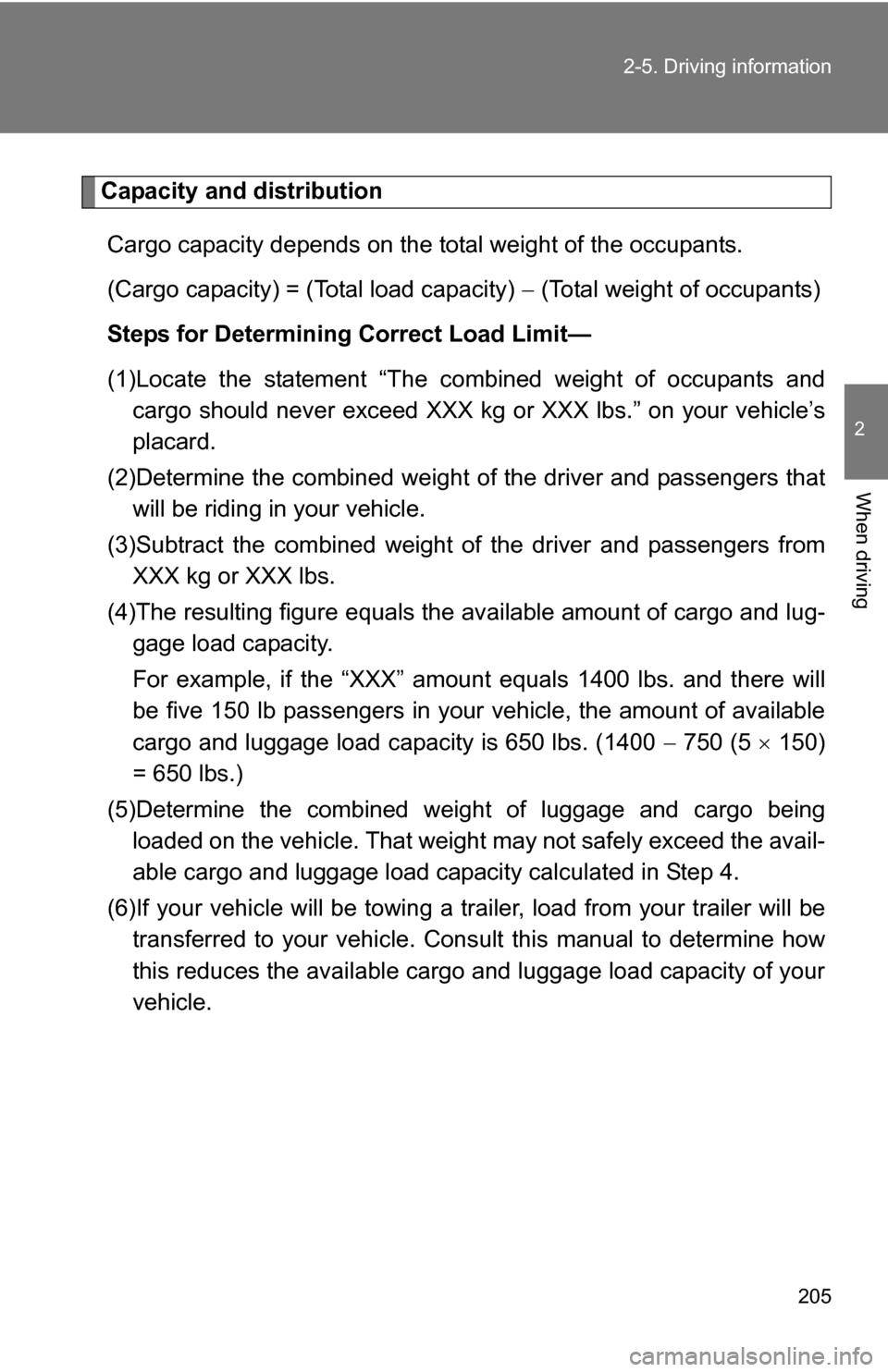
205
2-5. Driving information
2
When driving
Capacity and distribution
Cargo capacity depends on the total weight of the occupants.
(Cargo capacity) = (Total load capacity) (Total weight of occupants)
Steps for Determining Correct Load Limit—
(1)Locate the statement “The co mbined weight of occupants and
cargo should never exceed XXX kg or XXX lbs.” on your vehicle’s
placard.
(2)Determine the combined weight of the driver and passengers that
will be riding in your vehicle.
(3)Subtract the combined weight of the driver and passengers from XXX kg or XXX lbs.
(4)The resulting figure equals the av ailable amount of cargo and lug-
gage load capacity.
For example, if the “XXX” amount equals 1400 lbs. and there will
be five 150 lb passengers in your vehicle, the amount of available
cargo and luggage load capacity is 650 lbs. (1400 750 (5 150)
= 650 lbs.)
(5)Determine the combined weight of luggage and cargo being loaded on the vehicle. That weight may not safely exceed the avail-
able cargo and luggage load capacity calculated in Step 4.
(6)If your vehicle will be towing a tr ailer, load from your trailer will be
transferred to your vehicle. Cons ult this manual to determine how
this reduces the available cargo and luggage load capacity of your
vehicle.
Page 211 of 520
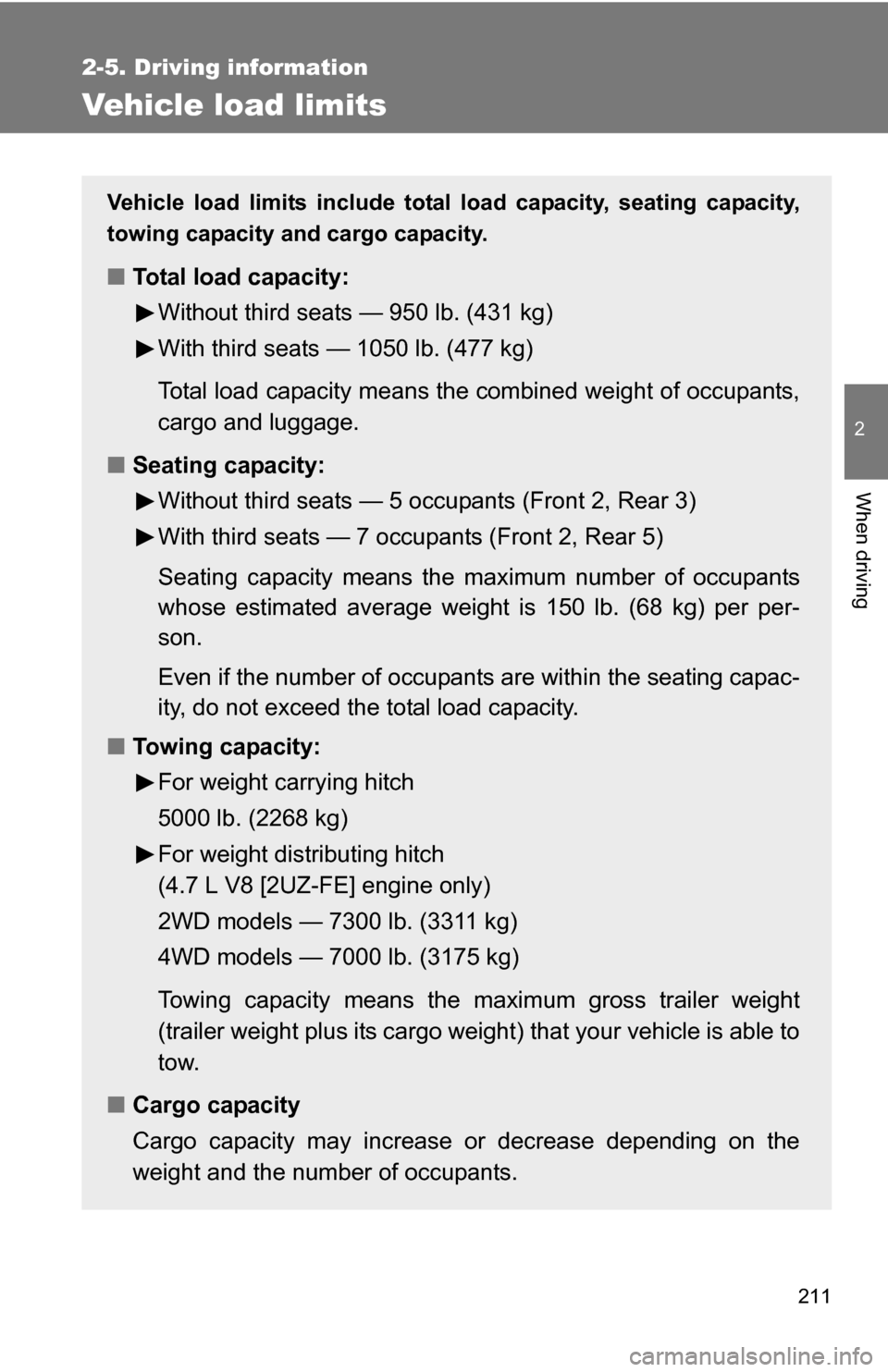
211
2-5. Driving information
2
When driving
Vehicle load limits
Vehicle load limits include total load capacity, seating capacity,
towing capacity and cargo capacity.
■Total load capacity:
Without third seats — 950 lb. (431 kg)
With third seats — 1050 lb. (477 kg)
Total load capacity means the combined weight of occupants,
cargo and luggage.
■ Seating capacity:
Without third seats — 5 occupants (Front 2, Rear 3)
With third seats — 7 occupants (Front 2, Rear 5)
Seating capacity means the ma ximum number of occupants
whose estimated average weight is 150 lb. (68 kg) per per-
son.
Even if the number of occupants are within the seating capac-
ity, do not exceed the total load capacity.
■ Towing capacity:
For weight carrying hitch
5000 lb. (2268 kg)
For weight distributing hitch
(4.7 L V8 [2UZ-FE] engine only)
2WD models — 7300 lb. (3311 kg)
4WD models — 7000 lb. (3175 kg)
Towing capacity means the maximum gross trailer weight
(trailer weight plus its cargo weight) that your vehicle is able to
tow.
■ Cargo capacity
Cargo capacity may increase or decrease depending on the
weight and the number of occupants.
Page 216 of 520
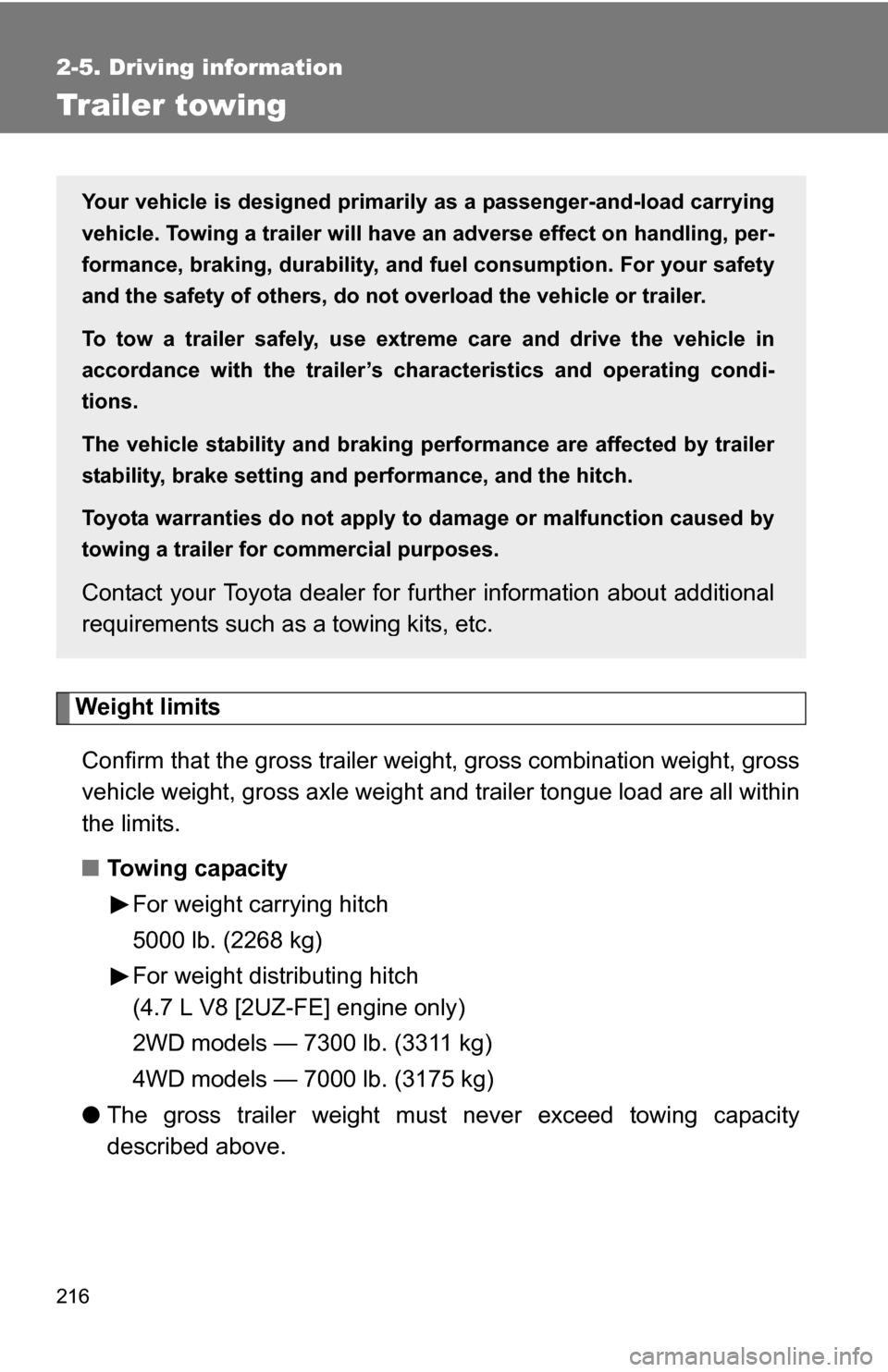
216
2-5. Driving information
Trailer towing
Weight limitsConfirm that the gross trailer weight, gross combination weight, gross
vehicle weight, gross axle weight and trailer tongue load are all within
the limits.
■ Towing capacity
For weight carrying hitch
5000 lb. (2268 kg)
For weight distributing hitch
(4.7 L V8 [2UZ-FE] engine only)
2WD models — 7300 lb. (3311 kg)
4WD models — 7000 lb. (3175 kg)
● The gross trailer weight must never exceed towing capacity
described above.
Your vehicle is designed primarily as a passenger-and-load carrying
vehicle. Towing a trailer will have an adverse effect on handling, per-
formance, braking, durability, and fu el consumption. For your safety
and the safety of others , do not overload the vehicle or trailer.
To tow a trailer safely, use extreme care and drive the vehicle in
accordance with the trailer’s char acteristics and operating condi-
tions.
The vehicle stability and braking performance are affected by trailer
stability, brake setting and performance, and the hitch.
Toyota warranties do not apply to damage or malfunction caused by
towing a trailer for commercial purposes.
Contact your Toyota dealer for fu rther information about additional
requirements such as a towing kits, etc.